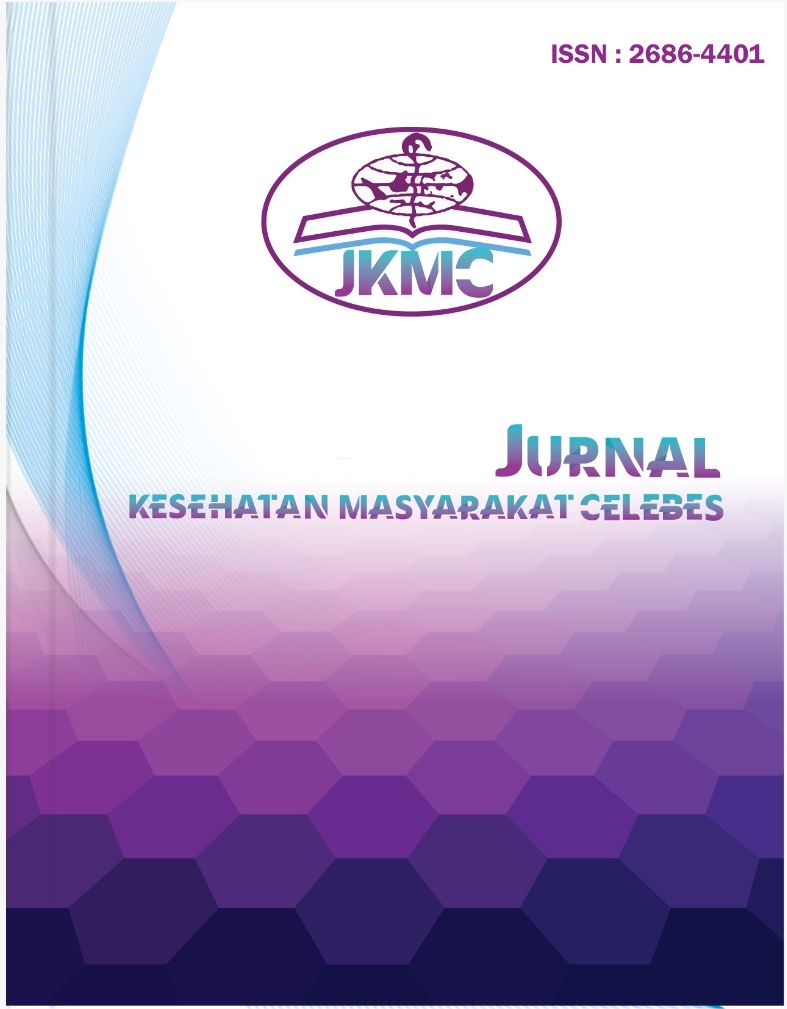Hubungan Penyakit Infeksi, Pendapatan Keluarga dan Pola Asuh Ibu dengan Status Gizi Balita di Pesisir Pantai Kelurahan Petoaha
Abstract
Toddler nutritional status is an indicator of Toddler health which is influenced by several factors such as infectious diseases, income and parenting. Nambo Health Center data in 2019 The prevalence of good nutrition is 90.47%, over nutrition is 0.24%, malnutrition is 8.9%, and malnutrition is 0.3%. Increased in 2020 good nutrition 85.49%, over nutrition 0.11%, less nutrition 13.53%, and poor nutrition 0.45%. The purpose of this study was to determine the relationship between infectious diseases, family income and parenting patterns with the nutritional status of children under five. Quantitative research design, cross sectional study approach. The population is all toddlers from fishing families aged 12-59 months in the coastal area of Petoaha, totaling 208 toddlers and a sample of 86 people obtained by purposive side. Data were analyzed using Fisher Exact test. The results showed that the relationship between infectious diseases and eating patterns with nutritional status was obtained with a p value of 0.000 and the relationship between income and nutritional status obtained a p value of 1,000. The conclusion of the study is that there is a relationship between infectious diseases and eating patterns with the nutritional status of children under five and there is no relationship between family income and the nutritional status of children under five on the Coastal Coast of Petoaha Village. Suggestions for the Petoaha Village Government, in order to establish a policy to improve the nutritional status of children under five. For mothers to provide good parenting and for further researchers, to analyze the dominant factors related to the nutritional status of Toddlers in Petoaha Village.
References
Carolin, B. T., Anggita, R. S., & Vivi, S. (2018). Analisis Faktor Yang Mempengruhi Status Gizi Balita (12-59 Bulan) Di Puskesmas Sukadiri Kabupaten Tangerang Tahun 2018. Jurnal Ilmu Dan Budaya, 41(66), 7835–7846.
Dinas Kesehatan Provinsi Sulawesi Tenggara, (2019). Profil Kesehatan Povinsi Sulawesi Tenggara.
Dinas Kesehatan Kota Kendari. (2019). Data Kesehatan Kota Kendari. Kendari : Dinkes Kota Kendari
Diniyyah, S. R. (2017). Asupan Energi , Protein Dan Lemak Dengan Kejadian Gizi Kurang Pada Balita Usia 24-59 Bulan Di DesaSuci, Gresik. Amerta Nutrition, 7(1), 341–350.
Handini, Dian. Hubungan Tingkat Pendapatan Keluarga Dengan Status Gizi Balita Di Wilayah Kerja Puskesmas Kalijambe. Diss. Universitas Muhammadiyah Surakarta, 2013.
Kemenkes RI., (2018). Profil Kesehatan Indonesia 2018. Jakarta: Kemenkes Ri.
Kemenkes RI., (2019). Riset Kesehatan Dasar tahun 2018. Jakarta: Kementrian Kesehatan Ri
Kemenkes RI.,(2019). Profil Kesehatan Indonesia 2018 Jakarta: Kemenkes Ri.
Nengsi, S. (2018). Hubungan Penyakit Infeksi Dengan Status Gizi Balita Di Wilayah Kerja Puskesmas Anreapi Kabupaten Polewali Mandar. J-KESMAS: Jurnal Kesehatan Masyarakat, 3(1), 44-57.
Nursalam. (2016). Metodologi Penelitian Ilmu Keperawatan. (P. P. Lestari, Ed.) (4th Ed.). Jakarta: Salemba Medika
Par’i, M Holil. Dkk, (2017). Penilaian Status Gizi.Https://Www.Google.Com/Url?Sa=T&Rct=J&Q=&Esrc=S&Source=Web&Cd=1&Cad=Rja&Uact=8&Ved=2ahukewiozj69vj_Fahuipi8khbpbbmeqfjaaegqichac&Url=Http%3a%2f%2fbppsdmk.Kemkes.Gd%2fpusdiksdmk%2fwp-Content%2fuploads %2f2017%2f11%2fpenilaianstatus-Gizi-Final
Pratiwi, Tiara Dwi, Masrul Masrul, And Eti Yerizel, (2016). "Hubungan Pola Asuh Ibu Dengan Status Gizi Balita Di Wilayah Kerja Puskesmas Belimbing Kota Padang." Jurnal Kesehatan Andalas 5.3
Puskesmas Nambo. 2020. Profil Puskesmas Nambo 2020. Nambo: Kota Kendari.
Soetjiningsih., & Ranuh, I. (2013). Tumbuh Kembang Anak Edisi 2. Jakarta: Egc. S
Supariasa, I.D.N., Bachyar Bakri, I. F. 2016. Penilaian Status Gizi (Edisi Revisi). Penerbit Buku Kedokteran. Jakarta: EGC.
Tri Susanti, (2018). Akademi Kebidanan Wira Buana Trieesharma@Gmail.Com Jurnal Kesehatan “Akbid Wira Buana” Volume 3 No 2, April 2018. Issn : 2541-5387
World Health Organization. (2019). Global Action Plan On Physical Activity 2018-2030: More Active People For A Healthier World. World Health Organization.








